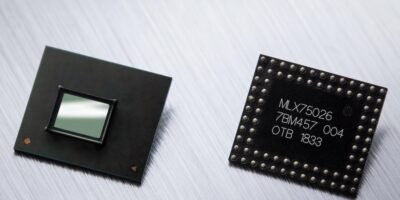ToF sensor has QVGA resolution to improve stray light operation
Integrating an infra red bandpass (IRBP) to eliminate the need for a separate infra red filter in the lens or sensor assembly, the MLX75026 time-of-flight (ToF) sensor improves system stray light performances, claims Melexis.
In addition to removing the need for a separate filter in the lens or sensor assembly, the ToF 3D camera reduces design complexity and cost, while creating more design choice when sourcing a lens.
The AEC-Q100-qualified QVGA (quarter video graphics array) ToF targets driver monitoring, in-cabin monitoring, gesture control, safety applications related to airbag deployment, head-up display (HUD) driver alignment in automotive design and industrial applications like automated guided vehicles (AGVs), elevator entry and (collaborative) robotics.
“An IR filter is mandatory in every ToF application to reduce out-of-band IR light in the operating environment, which could otherwise lower the dynamic range of the sensor,” explains Gualtiero Bagnuoli, optical sensors marketing manager at Melexis.
To integrate the correct IR bandpass filter, the passband must be adapted to the illumination for the filter to accept light from a wide range of incidence at minimal spectral shift (optically hard filter). This makes the use of ToF-lenses with high apertures (low f-number) easier yet Melexis believes it is the only ToF sensor manufacturer currently offering this option, in the form of the MLX75026. The MLX75026 is software-compatible with other Gen3 ToF sensors from the company.
The MLX75026 with IRBP filter has QVGA (i.e. 320×240 pixels) resolution with a ¼-inch optical format. It supports 940nm illumination. The sensor can be configured over an I2C interface and provides CSI-2 serial data output.
Samples of the MLX75026 with IRBP filter are available now. A compact high-performance evaluation kit incorporates a Xilinx Zynq Ultrascale+ MPSoC. The EVK75026+ quadruples the data bandwidth and frame rate of the earlier EVK75026 evaluation kit, yet is approximately half the mechanical size. It offers advanced pixel calibration and filtering functions, with on-demand support for features such as ambiguous range extension, multi-path resolving and interference rejection. The programming interface (API), written in C language, includes wrappers that allow the kit to be used with both Matlab and Python.




